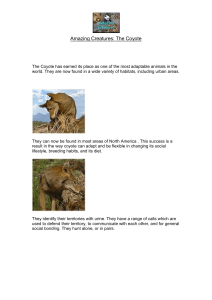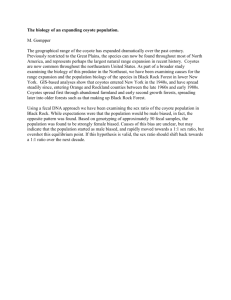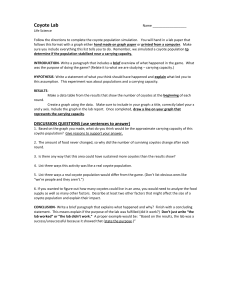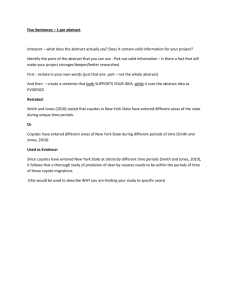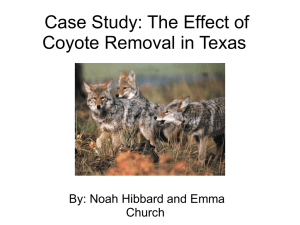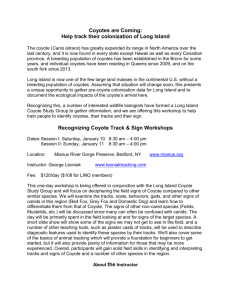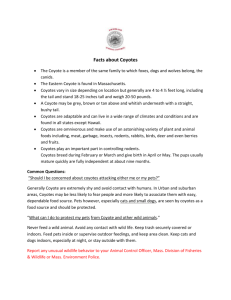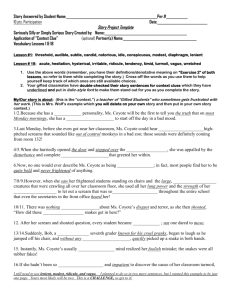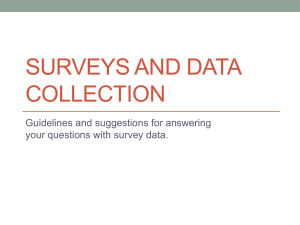Sussman Research Grant - Final Report
advertisement
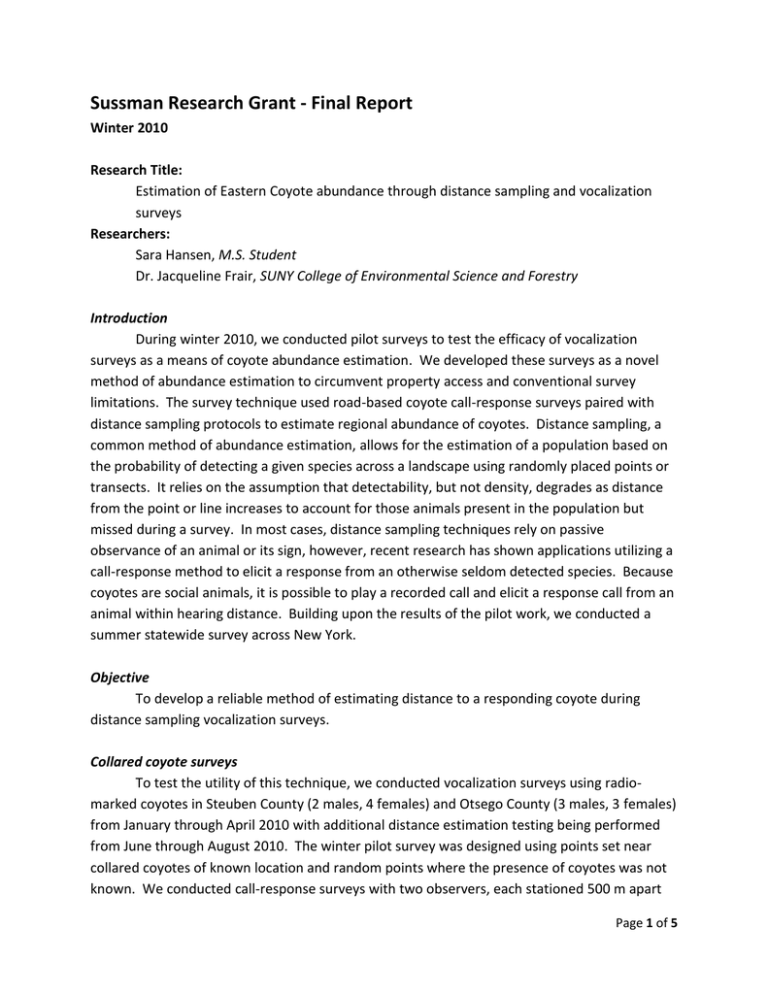
Sussman Research Grant - Final Report Winter 2010 Research Title: Estimation of Eastern Coyote abundance through distance sampling and vocalization surveys Researchers: Sara Hansen, M.S. Student Dr. Jacqueline Frair, SUNY College of Environmental Science and Forestry Introduction During winter 2010, we conducted pilot surveys to test the efficacy of vocalization surveys as a means of coyote abundance estimation. We developed these surveys as a novel method of abundance estimation to circumvent property access and conventional survey limitations. The survey technique used road-based coyote call-response surveys paired with distance sampling protocols to estimate regional abundance of coyotes. Distance sampling, a common method of abundance estimation, allows for the estimation of a population based on the probability of detecting a given species across a landscape using randomly placed points or transects. It relies on the assumption that detectability, but not density, degrades as distance from the point or line increases to account for those animals present in the population but missed during a survey. In most cases, distance sampling techniques rely on passive observance of an animal or its sign, however, recent research has shown applications utilizing a call-response method to elicit a response from an otherwise seldom detected species. Because coyotes are social animals, it is possible to play a recorded call and elicit a response call from an animal within hearing distance. Building upon the results of the pilot work, we conducted a summer statewide survey across New York. Objective To develop a reliable method of estimating distance to a responding coyote during distance sampling vocalization surveys. Collared coyote surveys To test the utility of this technique, we conducted vocalization surveys using radiomarked coyotes in Steuben County (2 males, 4 females) and Otsego County (3 males, 3 females) from January through April 2010 with additional distance estimation testing being performed from June through August 2010. The winter pilot survey was designed using points set near collared coyotes of known location and random points where the presence of coyotes was not known. We conducted call-response surveys with two observers, each stationed 500 m apart Page 1 of 5 and employed a series of coyote group-yip howls broadcast from a pair of loudspeakers to prompt a response from coyotes within hearing range. Each random point was spaced 6 km away from the next closest point to maintain sampling independence. When responses were heard, we estimated the number of coyotes responding and their distance from the person observing and each observer took a bearing to triangulate the position of the responding coyote(s). Pseudo-coyote surveys Call-response surveys using collared animals proved MS student Sara Hansen and problematic due to weather and road access thus requiring a technician Nick Deuel conduct secondary strategy to test distance estimation methods. These howling simulations to additional tests used simulated coyote responses from different determine distance estimation distances arranged in a grid format. Each call location was spaced accuracy. 250 m apart and call-response tests were conducted in a manner similar to tests with collared animals (Figure 1). Coyote calls were set off at each point location in a random order that did not allow for observers to know the distance at which the call was located during the test. If the call was heard, each observer recorded the bearing from which the call originated and provided an aural distance estimate. Wind speed and habitat information were also recorded. Each triangulation was processed to determine the estimated distance of the call from each observer. Triangulation distances and aural estimations were then compared with the true distance to determine average distance error for an observed call. Statewide survey Building on data gathered from the pilot tests, we produced and implemented a sampling design from June through August 2010 that provided good coverage throughout the major ecoregions within the state. A total of 770 points were identified while avoiding urban areas and heavily trafficked roadways (i.e. interstates and main highways). Each point was separated by no less than 6 km to ensure independence on a single survey night. Points were then assigned to 5-point Figure 1. Grid showing pseudo-coyote and observer “transects” (1 transect = 1/2 survey night, locations. Figure 2) that allowed approximately 10 to 15 Page 2 of 5 km between each transect to provide greater independence across the survey season. Surveys were conducted between dusk and dawn on wind free nights throughout the peak summer response period of late June through late August. Field crews consisted of three people and followed protocols established during the pilot. One observer was stationed at the point (with the call broadcast unit) and the other two stationed 500 m away in opposing directions. This allowed for greater detection of responses and increased our ability to triangulate the location of each response. Vocalization calls were broadcast in a set cycle of a 20-second call followed by a 2-minute listening period. This cycle was repeated three times, each call louder than the next. When a response was detected, the call cycle was stopped, each observer took bearings on all responding coyotes, and estimated distance based on call quality (Figure 3). A 5-minute listening period was added at the end of all responses to ensure all detectable responses were heard and recorded. Local weather conditions were recorded at the time of the survey and landscape attributes for the site were obtained from GIS layers. Figure 2. Two 5-point transects were surveyed each night. Figure 3. Bearings were taken to triangulate responses. Results Our distance estimation tests showed an average distance error of approximately 157 m for the triangulation method and approximately 174 m for the aural estimation method. By averaging the distance estimates of both methods, the average error decreased to approximately 140 m showing a slight improvement over individual methods. Preliminary results for the winter pilot effort yielded 32 call-response sessions involving known (i.e. collared) animals with a 34% response rate and 87 call-response sessions at random locations with a 24% response rate. The summer statewide effort has yielded a response rate of 23%. Control tests have shown moderate topographic variation, dense understory, and wind speeds greater than 5 kph lowered call detectability. The statewide effort resulted in a total of 579 points being successfully surveyed, of which, 151 points were discarded due to close proximity of houses and excessive noise (Figure 4). Responses were observed at approximately 100 points and multiple responses were observed at several points resulting in approximately 125 total responses observed during the surveys. Page 3 of 5 ² Figure 4. Location of survey points and responses during statewide effort. Discussion Distance estimation tests conducted showed a sufficient level of accuracy (<200 m) for use in the distance sampling methods being developed. Results indicate that given an appropriate number of observations from each surveyor, important information can be gained about individual observations biases. We conducted these tests in a forested landscape prompting the need for further trials in different habitat types to better understand the role of landscape in detection of a response. Initial results for random point count surveys indicate response rates sufficient to produce a credible population estimate. Analysis currently underway will provide necessary verification that road-based surveys captured the range of variation in ecological conditions encountered statewide that is needed to scale up to a statewide population estimate. Further analysis will provide information regarding coyote avoidance of roads that can be evaluated from GPS-collared animals. Future directions involve modeling the probability of detection for a given location to remove the need for classifying calls into distance categories, which could extend this approach to a citizen-science program for monitoring coyote populations. Acknowledgements Funds from the Edna B. Sussman Grant were used during the field portion of this study and research is ongoing. The Sussman Fund was gratefully aknowledeged during a poster Page 4 of 5 presentation of this research at The Wildlife Society’s annual conference in Snowbird, UT in October. Future scheduled presentations include talks at Montezuma Wildlife Refuge and the Vertebrate Conservation Conversation seminar at SUNY ESF. I would also like to thank the NYSDEC for their continued support, in particular, Scott Smith, NYSDEC Wildlife Biologist, for his time and energy during all phases of the project, my committee memebers, Dr. Brian Underwood and Dr. James Gibbs, and my amazing field crew who found a way to get it all done. Page 5 of 5
